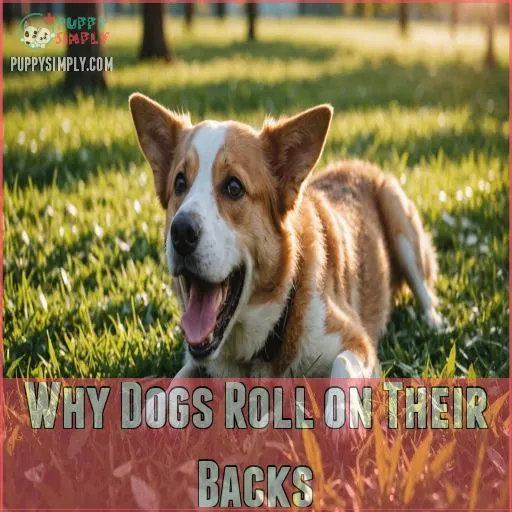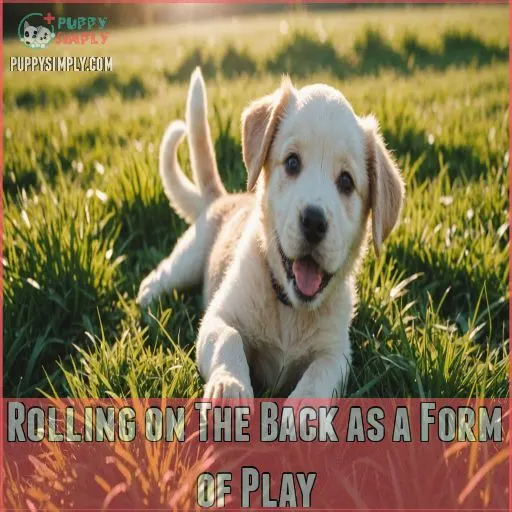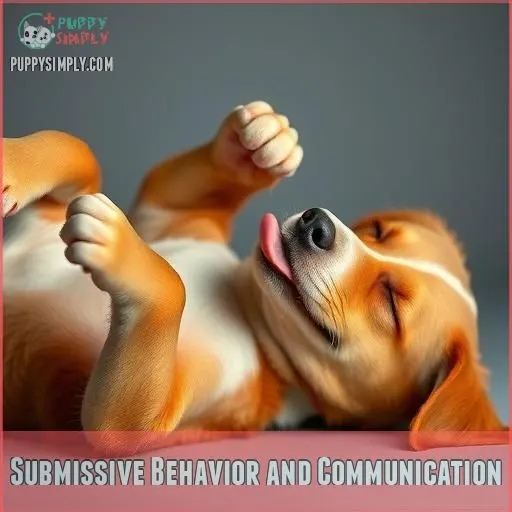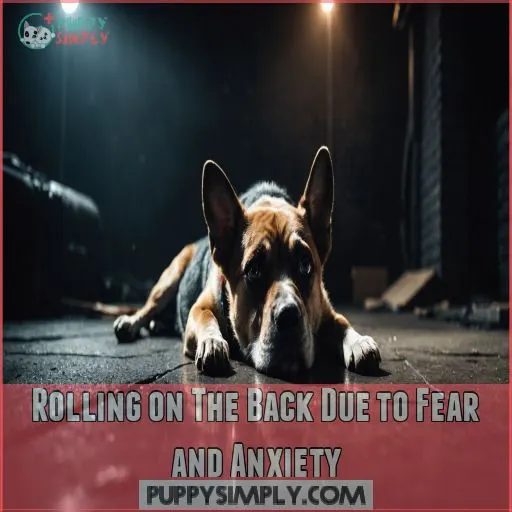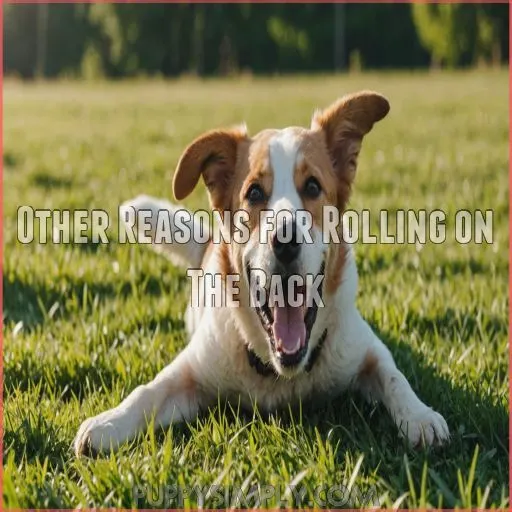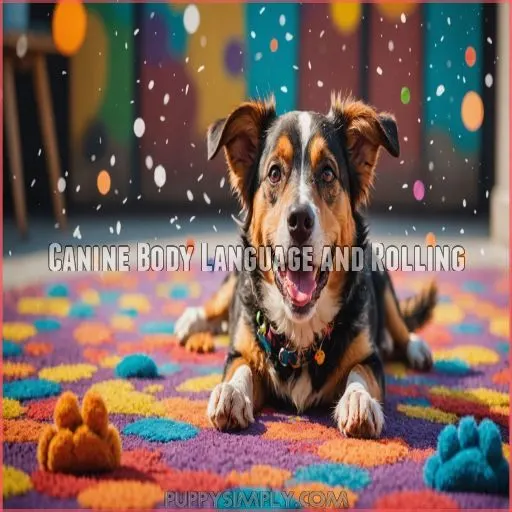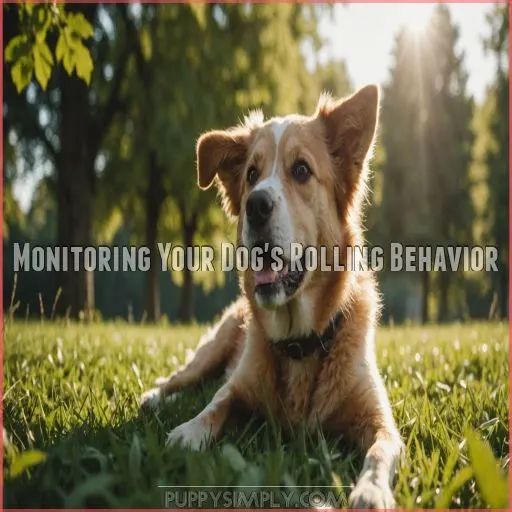This site is supported by our readers. We may earn a commission, at no cost to you, if you purchase through links.
 Why do dogs roll on their backs? It’s more than just a cute trick! Sometimes, they’re inviting playtime, a total goofball move.
Why do dogs roll on their backs? It’s more than just a cute trick! Sometimes, they’re inviting playtime, a total goofball move.
Other times, it’s a sign of submission, saying "I’m friendly, don’t worry!" They might also be relieving an itch, cooling down, or even just feeling comfy.
It can even signal anxiety, so pay attention to their body language. A stiff body with a tucked tail tells a different story than a loose, wiggly one.
Understanding your dog’s roll means understanding them better. Want to know how to tell the difference? There’s more to uncover…
Table Of Contents
- Key Takeaways
- Why Dogs Roll on Their Backs
- Rolling on The Back as a Form of Play
- Submissive Behavior and Communication
- Rolling on The Back Due to Fear and Anxiety
- Other Reasons for Rolling on The Back
- Health Concerns and Veterinary Care
- Canine Body Language and Rolling
- Why Dogs Roll on Their Backs and Make Noises
- Monitoring Your Dog’s Rolling Behavior
- Frequently Asked Questions (FAQs)
- Why do dogs roll on their backs and make noises?
- Why do dogs roll on their backs when playing?
- Why do dogs roll on their back when happy?
- Why do dogs roll over?
- Why do dogs roll on their backs and wiggle?
- Why does my dog roll around on her back on the carpet?
- What does it mean when a dog rolls over and shows his belly?
- Why do dogs roll on their backs in the grass?
- Do certain breeds roll more frequently?
- How does age affect rolling behavior?
- Can rolling indicate cognitive issues in dogs?
- Does diet influence a dogs rolling habits?
- Can weather changes impact rolling behavior?
- Conclusion
Key Takeaways
- Dogs roll on their backs for different reasons: it can be an invitation to play, a sign of submission, or a reaction to anxiety. Watch their body language to get the full story.
- If your dog rolls during playtime, they’re likely trying to engage in fun or test social hierarchies. Look for playful cues like a wagging tail and loose body.
- Rolling might indicate anxiety, especially if accompanied by signs like a stiff body or tucked tail. Create a safe environment to relieve their stress.
- Sometimes, dogs roll to scratch an itch or regulate their body temperature. If it becomes frequent, consider checking for allergies or other health issues with a vet.
Why Dogs Roll on Their Backs
You’ve probably wondered why your dog rolls on their back, whether it’s out of sheer joy or to communicate something deeper.
Dogs do this to invite play, show submission, express anxiety, or even scratch an itch, adding an amusing twist to their behavior.
Rolling for Play
When your dog rolls on its back during play, it’s not just showing you its belly; it’s inviting playful roughhousing and exhibiting canine body language for a good time.
This position offers a tactical advantage, letting your pup employ playful dominance or initiate social bonding without a hitch. It’s pure dog play joy!
- Inviting playtime
- Tactical maneuvers
- Encouraging interaction
- Social hierarchy testing
- Non-verbal communication
Rolling for Submission
After playful antics, a dog might expose its belly as a sign of submission.
This belly exposure signals peace, not just a plea for tummy rubs. It’s a greeting ritual within the pack dynamics, showing you’re the top dog without a bark.
In such pack dynamics, dogs may also display pack mentality, laying on their owners to reinforce their social hierarchy.
Some dogs might even exhibit submissive urination, clarifying their non-threatening stance in the dominance hierarchy .
Rolling for Anxiety
Your dog’s back rolling might be anxiety’s whisper, seeking comfort.
Look for these signs:
- Stiff body: An anxiety trigger that suggests stress management is needed.
- Ears back: Indicates fear, requiring safe spaces.
- Wide eyes: Signal for calming techniques or vet consultation.
- Tail tucked: Reflects dog fear, prompting canine communication to soothe them.
Understanding pet behavior helps immensely.
Rolling for Health Reasons
Imagine this: your dog joyfully rolling on its back, not for fun but to cope with an itch from allergies or skin infections.
It’s a clever and natural way to scratch that unreachable spot.
However, if it’s frequent, consider veterinary care.
Keep an eye on those itchy moments—they might need medication or other assistance for better pet health (Source).
Rolling on The Back as a Form of Play
You might notice your dog rolling on its back with a wagging tail and a playful grin.
This behavior is often an invitation for some fun, whether it’s with another dog or you, sparking joy and delightful chaos in your living room.
Inviting Playful Interaction
A common dog play signal is rolling onto their backs.
This playful body language often means they’re inviting interaction.
Think of it as a canine "come play with me!"
To encourage this behavior, use positive reinforcement tools like effective clickers.
Watch for other cues like a loose, wiggly body and an open mouth.
These social play cues indicate a fun invitation, not submission.
Ignoring these signals could lead to misunderstandings.
Remember, puppy play behavior often involves similar postures.
Understanding your dog’s communication, including their love bites which are a form of canine communication, conveying affection and connection through gentle mouthing techniques, is key to building a strong bond.
Playful Dominance
So, your playful pup rolls onto their back, looking all innocent yet full of mischief.
It’s more than an invitation to play; it shows playful dominance.
They might be ready for some playful wrestling or to launch a playful nipping session.
This behavior isn’t about surrendering; it’s a cheeky tactic to engage and rule the playtime scene.
Strategic Play
Ever notice your dog rolling on its back during play? They’re not just being cute! This strategic move often serves as:
- A tactical advantage to surprise another dog
- A form of self-handicapping to level play
- An invitation for playful roughhousing
- A way to avoid escape bites
It’s like a furry game of chess, every move counts!
Submissive Behavior and Communication
When your dog rolls over with its belly up, it’s not just seeking a tummy rub; this gesture often signals submission and communicates, "I mean you no harm."
It’s also a clever way to calm down tense situations and say hello to new friends, whether they’re human or canine.
Signs of Submission
While your dog might roll over during play, this gesture can also signal submission.
Watch for signs like tail tucking, lip licking, ears flattened, avoiding eye contact, and even yawning excessively.
Through these body language cues, your dog communicates humility and non-threat.
Recognizing these subtle signs helps you understand your furry friend’s feelings and strengthens your bond.
Calming Down a Situation
Dogs often roll onto their backs as a calming technique, signaling submission and reducing tension.
Imagine it as a dog’s way of waving a white flag.
To understand this behavior better, notice these cues:
- Relaxed body language indicating calmness.
- Exposing the belly as a calming signal.
- Reduced aggression or anxiety.
- Use of calming signals to ease social situations.
Greeting People or Other Dogs
Imagine the scene: your furry friend rolls onto their back, tail wagging like it’s signaling peace.
They expose their belly as a friendly "hello" to you or other dogs, signaling no harm is meant.
This submissive gesture, paired with playful bows and sniffing, paves the way for social interactions, inviting belly rubs and companionship.
Rolling on The Back Due to Fear and Anxiety
When you notice your dog rolling on their back, it’s important to pay attention to the context, as this behavior can sometimes indicate fear or anxiety.
If your dog is rolling on their back due to fear or anxiety, you might notice signs like a stiff or trembling body, and it’s important to remove them from the stressful environment to help them feel more comfortable.
Signs of Anxiety
Sometimes, a submissive roll becomes a sign of anxiety.
It’s not always about yielding; your pup might be feeling scared.
Look for other clues: Is their tail tucked? Are they panting heavily, shaking, or lip-licking excessively? These, along with yawning (Source), suggest anxiety.
You might even see displacement behaviors like excessive sniffing.
A fearful dog might also show signs of avoidance.
Coping Mechanisms
Your dog’s tail-wagging joy might hide a bit of stress and anxiety.
Rolling on their back can be a stress-relief tactic, addressing anxiety triggers.
It’s a self-soothing behavior that taps into calming techniques.
Think of it as their personal yoga session!
| Emotion | Behavior | Benefit |
|---|---|---|
| Fear | Rolling | Calm |
| Anxiety | Sniffing | Focus |
| Stress | Playing | Joy |
Removing Stressors
After exploring coping mechanisms, it’s time to focus on removing stressors.
Creating a stress-free environment for your dog can ease anxiety.
Try these steps:
- Safe Spaces: Design a cozy corner with familiar smells.
- Anxiety Relief: Use calming techniques like soothing music.
- Fear Management: Gradually expose your dog to triggers.
- Routine: Stick to a predictable schedule for comfort.
Other Reasons for Rolling on The Back
You might notice your dog rolling on their back, not to play or submit, but simply to relax or get your attention.
Sometimes, they’re just trying to cool down or enjoy a good stretch, proving that dogs are the masters of chill.
Regulating Body Temperature
Imagine your dog as a furry solar panel, soaking up the sun to cool down.
Dogs roll on their backs to expose their bellies, allowing heat to escape efficiently.
Combined with panting, this helps regulate their body temperature.
And don’t forget those cooling pads and shady spots—they’re not just decor; they’re important for keeping your pup comfy!
| Technique | Purpose | Details |
|---|---|---|
| Panting | Cooling | Evaporates moisture to reduce heat. |
| Shading | Protection from sun | Offers a cooler environment for resting. |
| Water sources | Hydration and cooling | Essential to maintain body temperature. |
| Cooling pads | Direct cooling relief | Assists in keeping your dog cool. |
| Behavioral changes | Observing temperature effects | Lookout for signs like seeking cooler spots. |
Stretching or Relaxing
When it’s not about cooling off, rolling on their backs can be a dog’s version of stretching or relaxing, as it helps them find relief from frustration and stress.
Allowing muscle relaxation, it’s like canine yoga—deep breathing, body awareness, and all.
Dogs may use this posture to manage stress, much like creating a safe space for retreat.
Just as you might stretch to relieve stress, dogs find stress relief in this posture, too.
Plus, they might plain enjoy the sensation! (Source)
Attention-Seeking Behavior
While stretches might feel good, rolling can also be a clever attention-seeking trick.
You might notice your dog flopping over with a dramatic flair, hoping for playful nudges or cuddly demands.
It’s their way of saying, “Hey, look at me!”
Sometimes, this performance includes whining for treats or loud barks, like a furry little drama queen.
Health Concerns and Veterinary Care
Sometimes that adorable belly-up roll isn’t just playful; it could signal an itchy problem or even an infection.
If your dog’s rolling seems excessive, or they’re showing other signs of discomfort, it’s always best to check in with your vet—they can help you figure out what’s up and get your furry friend feeling better.
Allergies and Skin Infections
If your dog rolls on its back more than usual, it might’ve allergies or a skin infection.
Common allergy triggers include pollen, dust, and certain foods, causing scratching behavior and visible skin infection symptoms.
Home remedies can soothe mildly affected skin, including applying a warm compress to alleviate discomfort caused by anal gland issues, but don’t hesitate to consult a vet for persistent issues.
It’s essential for your pup’s health!
Itching and Scratching
Fleas, ticks, and mites – common triggers of intense itching that can be found in dog itching remedies. Skin allergies often provoke relentless back-rolling in dogs.
This habit might indicate itching issues they can’t scratch easily.
Consider exploring DIY remedies or scratching tools at home to provide relief.
Yet, keep an eye out for hot spots or fleas, as they’re common culprits.
Flea treatments can be handy when your pup continuously rolls like they’re auditioning for a new dance.
Veterinary Advice
Dealing with your pup’s itchy back can jump into the area of skin allergies and infections.
These might need medication options or itchy skin remedies.
Don’t play the guessing game—it’s time for vet visits.
They can prevent parasites and help spot the cause.
You and your pooch deserve peace, not scratching marathons!
Canine Body Language and Rolling
When your dog rolls on its back, it’s not just for belly rubs; this behavior can reveal a lot about its feelings and intentions.
By observing a loose, wiggly body and an open mouth, you can decipher if your pet is feeling playful, relaxed, or something else entirely.
Context Matters
Understanding the context of when your dog rolls on their back is important.
Different situations, like age, breed, or environment, influence this behavior.
For instance, a young pup may roll playfully, while an older dog may do it out of habit or anxiety.
Each dog’s individuality shines through, and recognizing these subtle cues helps you respond appropriately, creating a harmonious relationship.
Loose, Wiggly Body Language
Imagine your dog rolling on their back with a loose, wiggly body, radiating playful energy.
This body language is a delightful invitation to join in the fun.
Key cues include:
- Tail wags energetically.
- Relaxed posture shows comfort.
- Body language cues like wiggling suggest playfulness.
- A gentle demeanor signals friendliness.
It’s a dog’s way of saying, "Let’s play!" .
Open Mouth and Relaxed Posture
Observing canine contentment is key to understanding your furry friend.
Dogs displaying fear or resource guarding behavior often exhibit aggressive traits, such as Shih Tzu Aggression Signs. A relaxed dog often displays open mouth signals, a hallmark of playful body language.
This, combined with a loose, wiggly posture, is a happy cue!
Here’s a helpful guide:
| Relaxed Body Language | Open Mouth Signals |
|---|---|
| Loose, wiggly body | Panting, slightly open mouth |
| Relaxed ears, almond eyes | No lip tension, upward corners |
| Neutral tail position | Tongue lolling out |
| Soft, un-tensed muscles | Mouth closed or slightly open |
| Belly exposed | Teeth may be visible |
Remember, context matters!
Why Dogs Roll on Their Backs and Make Noises
When your dog rolls on their back and starts making noises, they’re not just putting on a show—they might be communicating excitement or stress.
Listening to these funny little sounds helps you understand whether it’s playtime or your pup needs a bit of comfort.
Vocalizations During Rolling
Some dogs’ vocalizations during rolling can be as varied as a summer barbecue playlist.
You’ll often hear:
- Playful yelps: Signaling excitement and happiness.
- Anxiety whines: Indicating stress or fear.
- Growls vs. barks: Differing tones suggest play or defense.
- Silence during roll: A content, introspective moment.
Understanding these sounds strengthens the bond with your furry friend.
Communicating Playfulness or Anxiety
While your dog might roll on their back and make noises for play, it could also mean they’re anxious, similar to how they might circle around due to excitement.
Look for playful signals like a wagging tail or loose body, indicating fun.
Conversely, tense muscles or wide eyes suggest anxious behaviors.
By understanding dog body language, you can better respond to their needs, ensuring your furry friend feels safe and content.
Monitoring Your Dog’s Rolling Behavior
You’ve probably wondered if your dog’s rolling behavior is normal or cause for concern.
Pay attention to any changes and watch for signs of distress.
And don’t forget those regular vet visits to keep everything in check!
Changes in Rolling Behavior
Dogs might make amusing noises while rolling, but monitoring changes in their rolling behavior is important.
Notice when these patterns shift. Changes could be key indicators.
Consider these:
- Frequency: Is your dog rolling more or less than usual?
- Intensity: Has the way your dog rolls changed noticeably?
- Timing and Duration: Are these rolls happening at unusual times or lasting longer?
Signs of Distress
Keep an eye on your dog’s rolling habits; they might be signaling distress.
If they show signs like panting, trembling, or pacing, it’s a cue that something’s awry.
Whining or hiding might add to this puzzling picture.
Sometimes, our four-legged companions just can’t speak up, so it’s up to you to become a body language detective.
Regular Veterinary Check-Ups
Peace of mind comes with monitoring your dog’s rolling behavior.
Schedule regular veterinary check-ups to catch potential health issues early, such as allergies or skin infections.
Your vet can provide guidance on preventative care, vaccine schedules, and routine exams to help your dog stay healthy and happy.
Early detection is key to a long, happy life.
Frequently Asked Questions (FAQs)
Why do dogs roll on their backs and make noises?
You might think your pup is pulling wool over your eyes, but rolling and making noises often signals playfulness or seeking affection.
They might also be masking their scent or simply scratching an itch.
Why do dogs roll on their backs when playing?
Dogs roll on their backs during play to gain a tactical advantage or invite playful interaction.
It’s not always submission; rather, they’re trying to escape bites or launch attacks, like furry martial arts experts.
Why do dogs roll on their back when happy?
When your dog rolls on its back, it’s often a sign of happiness, showing trust and relaxation.
This behavior invites friendly interaction, perhaps a belly rub, and signals they’re comfortable and content in your presence.
Why do dogs roll over?
It’s all in the cards when pups roll over; they might seek a belly rub, scratch an itch, or make peace.
Sometimes, it’s about adopting a playful strategy or just a quirky, smelly cologne.
Why do dogs roll on their backs and wiggle?
You’re witnessing a delightful doggie dance!
Dogs roll on their backs and wiggle to scratch itches, play, or signal joy.
It’s like their version of a happy shimmy, saying, "Life’s good; give me belly rubs!
Why does my dog roll around on her back on the carpet?
Your home carpet is like a warm hug for your dog – a place to feel safe and relaxed.
She rolls on her back to mark it with her scent, relieving anxiety and stress.
What does it mean when a dog rolls over and shows his belly?
A belly-up dog might show trust, submission, or just want a scratch!
Sometimes, they’re cooling down or masking their scent.
Watch their body language; a stiff body means "leave me alone!
Why do dogs roll on their backs in the grass?
Picture your dog basking in sunlight on soft grass, utterly blissful.
Dogs roll on their backs in the grass for fun, to scratch an itch, or to capture and communicate scents—like their version of a postcard.
Do certain breeds roll more frequently?
Certain dog breeds, like Dachshunds and Beagles, may roll on their backs more often due to their playful nature and instinctive behaviors.
They love exploring their surroundings, and rolling can be a joyful way to engage.
How does age affect rolling behavior?
As dogs age, their rolling behavior may change due to altered energy levels and mobility constraints.
Older dogs might roll less frequently than playful puppies, focusing instead on comfort and conserving energy for essential activities.
Can rolling indicate cognitive issues in dogs?
Isn’t it curious how a dog’s antics, like rolling on its back, can sometimes signal hidden issues?
Though it often indicates playfulness, if paired with odd behaviors, cognitive impairment may be worth exploring.
Does diet influence a dogs rolling habits?
Your dog’s diet can influence their rolling habits.
After a satisfying meal, they might roll joyfully, expressing contentment.
Conversely, discomfort from an unbalanced diet could lead to rolling for relief, similar to finding that perfect couch spot.
Can weather changes impact rolling behavior?
Weather changes might impact your dog’s rolling behavior due to shifts in air pressure.
Dogs, sensitive to these changes, may react similarly to thunderstorms, showing different behaviors like more frequent rolling to cope with new sensations.
Conclusion
So, understanding why dogs roll on their backs is key to canine communication.
It’s rarely just a random roll; it’s a complex canine conversation.
Sometimes it signals playful submission, other times, anxiety.
Observe your dog’s whole body—a stiff posture differs greatly from a relaxed one.
Consistent, careful consideration of their body language helps you decipher their doggy desires.
So next time your dog does a back roll, remember: it’s more than just a cute trick; it’s a message.
Knowing why dogs roll on their backs enhances your bond.

